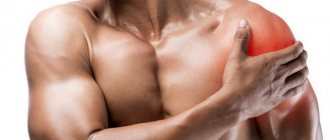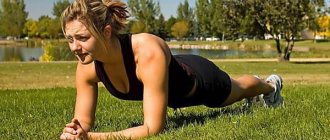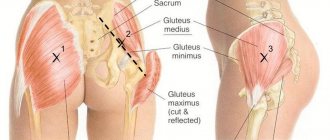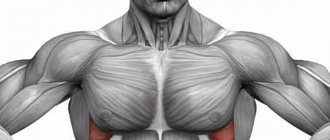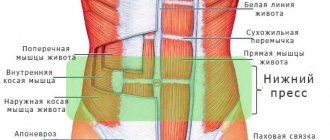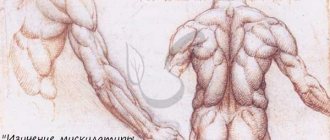Heavy loads and too fast movements without prior physical preparation lead to muscle tissue sprains. All muscle groups and tendons are susceptible to it, as they are subject to constant contractions. The muscles most often affected are the lower leg, thigh, shoulder and forearm, so the treatment regimen in each individual case can vary significantly.
What is a muscle strain?
According to ICD-10, this injury has code M 62.0. Muscle stretching or distortion is an injury to the tissues of the ligamentous-muscular apparatus that does not cause a violation of their anatomical integrity.
Excessive muscle tension occurs due to the fact that the loads acting on them significantly exceed their elasticity, and sudden movements do not coincide with the direction of the joints. Damage to muscles is often accompanied by hemorrhages in their thickness and painful sensations.
Human muscular system
Sprains range in severity from minor injuries to tissue tears. Damage to the ligaments and muscles of the back is the most dangerous case. The most vulnerable muscles are in the lumbar and cervical regions.
Causes of sprains
The most common causes of distortion are:
- unsuccessful falls with dislocations;
- lifting weights;
- intense physical activity;
- sudden movements in the joints;
- staying in an uncomfortable position for a long time;
- poorly developed muscle corset;
- lack of warm-up and “warming up” of muscles;
- incorrect body position when playing sports.
As a rule, athletes or people engaged in regular heavy physical labor suffer from this disease in a chronic form. Acute sprain occurs with one-time heavy loads without prior preparation.
Symptoms and signs
Muscles that have been subjected to intense stress do not immediately begin to hurt. Over the course of several days, short microfibrils or muscle fibers tear, which causes severe pain, often accompanied by swelling and tissue hematomas. Each damaged muscle group has its own symptoms, shown in the table below.
| Type of muscles | Signs |
| Thigh muscles |
|
| Muscles of the arms (shoulders, wrists) |
|
| Leg muscles (foot, calf, femoral, quadriceps, adductor, gluteal) |
|
| Back muscles |
|
| Neck muscles |
|
| Groin muscles |
|
| Abdominal muscles |
|
Symptoms
It is not uncommon for people who participate in athletics to experience a strained calf muscle. Symptoms and treatment for various injuries of this kind are similar. The main symptoms include pain at the site of the lesion and swelling of the soft tissues. In rare cases, a hematoma may occur.
It is enough to simply identify a patient with a muscle strain. Treatment should be started as early as possible if pain leads to stiffness of movement. In this case, the patient cannot lead a normal life and constantly complains of discomfort in the affected area. Severe pain may occur when attempting to resume physical activity. This can be explained quite simply: ligaments contain a huge number of blood vessels, as well as nerve endings.
Diagnosis of sprains
In case of muscle sprains, it is recommended to consult a doctor, but in most cases it is enough to just perform an external examination of the damaged part of the body, palpation, and sometimes an x-ray to identify the presence of other concomitant injuries - dislocations and fractures.
In severe cases, an ultrasound is prescribed, which makes it possible to distinguish a muscle sprain from a muscle rupture.
Which doctor treats a muscle strain?
The victim should go to the emergency room or the reception desk of a local clinic as soon as possible. The necessary assistance can only be provided by a specialist in pathologies of the musculoskeletal system - a traumatologist, surgeon, or orthopedist. Most often, the doctor makes a diagnosis based on the results of an x-ray.
Signs of a muscle strain
Causes of pain
Pain in the soft tissue area occurs for various reasons. They can be both physiological and associated with pathological processes in the human body.
Physiological
If the leg muscle above the knee hurts, then the reason does not necessarily have to be the development of any disease. Most often, causeless pain is provoked by excessive physical exertion, so it often worries people who are actively involved in sports or do physical work.
The occurrence of a pain symptom in this case is associated with stagnation of lactic acid in the muscles. It causes painful sensations that last for 2-3 days and have a burning character.
Another physiological reason that causes aching pain in the leg muscles is wearing uncomfortable shoes. This is especially true for women who prefer to wear high heels. In this case, you should select your shoes more carefully.
Staying in one position for a long time can cause pain. In such a situation, the blood vessels are compressed, the muscles are tense, and they do not receive enough nutrition. This entails numbness of the tissues, a stabbing sensation, and nagging pain. Unpleasant signs disappear immediately after blood flow is restored.
Also, muscle pain is a frequent companion of women carrying a child. It especially manifests itself in late pregnancy. The reason lies in the increased load on the legs, which occurs due to weight gain.
Pathological
If pain in muscle tissue is accompanied by other symptoms, then there is a high risk of developing diseases of the leg muscles, joints or bones. The following diseases can provoke pain:
- Fibromyalgia. This is an extensive lesion of the leg muscles, in which dull pain is observed. It is localized in different parts of the limb.
- Cramps. This phenomenon is associated with insufficient amounts of calcium, magnesium and potassium in the body, as well as dehydration. The favorite place of the syndrome is the calves. The patient experiences severe pain, accompanied by tissue stiffness and a burning sensation.
- Myositis. The disease is inflammatory in nature. In most cases, it develops as a result of viral pathology and excessive physical stress on the legs. The pain in front above the knee or behind it is dull and growing in nature.
- Osteomyelitis. The pathology occurs due to the penetration of infection into bone tissue, accompanied by a purulent process spreading to the muscles. The pain with such a disease is very pronounced, sometimes the aches are simply unbearable.
- Neuralgia. The disease occurs due to pinched nerves. As a result, the leg ache severely, pain permeates the tissues. The appearance of the symptom is often associated with a sudden movement of the hip.
- Intervertebral hernia. With a tumor in the vertebrae, pain can radiate to the femoral area. Patients often experience numbness in their limbs.
If you suspect the development of these pathologies, you should consult a doctor. You may need to be examined by specialists such as a neurologist, phlebologist, or orthopedist.
Timely consultation with a doctor is necessary in order to prevent conditions that pose a threat to human life.
First aid for muscle strain
Before visiting the hospital, first aid is limited to such manipulations as:
- fixation of the limb with an elastic bandage or splint to limit its mobility in order to prevent hemorrhage in the tissues;
- cooling the sprain site with ice to reduce swelling;
- temporary pain relief with analgesics.
IMPORTANT! Under no circumstances should you rub the damaged area, as this will lead to tearing of even more muscle fibers and aggravate the situation. The patient should avoid sudden movements.
Applying cold compresses directly to the skin is not advisable because it can impair circulation. It is recommended to wrap the ice pack in a towel and only then apply it to the surface of the skin. It is strictly forbidden to cool an injury with an open wound.
First aid
Tick bite
Lyme disease and spotted fever are dangerous infectious diseases. They are carried by ticks. After the bite, flu-like symptoms appear. Often these are chills, nausea, and skin rashes. These diseases are also the reason why your muscles hurt. Aches appear at the very beginning of the disease. It is accompanied by weakness and fatigue. If these symptoms occur, you should immediately consult a doctor.
Sprain treatment
Even with minor tears of muscle fibers, the patient should not neglect qualified medical care.
If treatment is not treated in a timely manner, consequences such as weakening of joints, arthrosis, and a tendency to dislocation may occur. There may be a crack in the bone associated with the damaged muscle, which can only be diagnosed by x-ray.
Recovery time depends on the severity of the damage. If the ligaments are damaged along with the muscles, then the treatment is longer.
In official medicine, there are several approaches to the treatment of sprains:
- Drug therapy.
- Physiotherapy and massage.
- Physical exercises and gymnastics.
- Yoga.
- Fixation of injured limbs.
- Operation.
Severity of sprain
Medicines
The most common treatment for mild to moderate muscle injuries is the use of warming gels and ointments 48 hours after the sprain and pain medications.
Treatment is carried out with popular drugs shown in the table:
| Drug name | Compound | Effect | Directions for use, dosage |
| Dimexide (gel, solution, ointment) | Dimethyl sulfoxide | Anesthesia and elimination of inflammation. The solution is used for warming compresses. The gel quickly penetrates the skin and acts directly on damaged tissue. | Apply to skin 1-2 times for 2 weeks. |
| Diclofenac (tablets, ointment, gel, ampoules) | Diclofenac | Relieves pain and inflammation. The ointment contains 0.3 g of active substance and actively penetrates the skin and enters the muscles and joints. | 75 mg/day intramuscularly for 1-5 days, tablets – 100-150 mg/day. Gels and ointments – rub into the skin 2-3 times a day for 2 weeks. |
| Menovasin ( ointment, solution) | Racementol | Menovazine is used for local anesthesia. Menovazin ointment is effective as a rub. | Rub the area of inflammation 2-3 times a day for a month. |
| Ketonal (tablets, gel, cream, solution for o/v) | Ketoprofen | Relieves pain of varying intensity and origin. Ketoprofen in the composition acts both when taken externally and when taken orally. The drug blocks the work of enzymes that provoke inflammation. | 1 tablet 2-3 times a day during or after meals, IM solution – 1-2 times a day. Cream or gel is used for rubbing 2-3 times a day for 14 days. |
| Ibuprofen (tablets) | Ibuprofen | Relieves pain, inflammation and fever. The medicine is quickly absorbed by the gastrointestinal tract and excreted by the kidneys within 2 to 3 hours after administration. | Drink on an empty stomach and between meals according to the recipe and instructions. |
| Nise gel | Nimesulide | Eliminates inflammation in muscles and joints, inhibits destructive processes in cartilage, relieves swelling and pain. The gel is quickly absorbed by the skin, has a pleasant smell, and does not stain clothes. | The gel is not rubbed in, but applied to the skin 3-4 times a day. |
| Xefocam (tablets, injections) | Lornoxicam | Relieves pain by inhibiting PG synthesis enzymes and does not change the state of physiological parameters of the body. The drug is non-toxic and is quickly eliminated from the body. | The daily dose of the drug is 16 mg of active substance. |
| Indomethacin (ointment) | Indomethacin | It has an anti-inflammatory and anti-edematous effect and causes local anesthesia. It is not recommended to apply the drug to injuries with wounds and mucous membranes. | The ointment is applied 2-3 times a day for 2 weeks. |
| Capsicam (ointment) | Camphor, dimethyl sulfoxide, pine needle oil | Has a warming effect on damaged tissues. The skin temperature at the application site increases and this stimulates blood circulation, which accelerates tissue restoration. | The ointment is applied to the affected area of skin and lightly rubbed. The duration of treatment is 10 days. |
| Heparin ointment | Heparin | The ointment has anti-inflammatory and analgesic effects. Heparin prevents the formation of blood clots by dilating blood vessels. | Rub into skin 2-3 times a day for 3-7 days. |
Physiotherapy
Physiotherapy is used to treat sprains using physical principles, does not cause allergic reactions, has a gentle effect on the body and strengthens the immune system.
The main areas of therapy are:
- Magnetic therapy stops inflammation in damaged tissues and activates their regeneration.
- Electrophoresis delivers drugs through the skin using an electric field.
- Myostimulation is the effect on muscles of electrical impulses. Allows you to restore the elasticity of muscles and ligaments, strengthen the muscle corset, improve blood circulation, and accelerate the regeneration of damaged tissues.
- Ultrasound treatment is based on the action of sound vibrations with a frequency of 800 to 3000 Hz. Ultrasound therapy reduces pain and inflammation, resolves swelling, improves blood circulation and lymph outflow. A related technique is phonophoresis, that is, the simultaneous effect of ultrasound and drugs on the body.
- Laser treatment is used to prevent pain and inflammation. The procedure lasts from 10 minutes, is absolutely painless and combines well with other treatment methods.
Massage
Massage can be done 48 hours after the injury.
The procedure is carried out in two stages:
Foot massage
- Preparatory – the area located above the damaged area is massaged, which improves blood circulation and lymph drainage. To enhance the effect, massage is performed on both the sick and healthy sides. It is carried out with planar and grasping movements of the palms and fingers.
- The main one is carried out in the damaged area in the direction of venous outflow.
The course includes about 14-16 procedures lasting from 5 to 20 minutes.
Exercises and gymnastics
Therapeutic exercise involves carefully dosed loads on muscle groups that need to be healed and strengthened.
Exercises for back muscles
Therapeutic gymnastic exercises are divided according to two principles:
- anatomy – exercises are aimed at specific muscle groups;
- intensity – active, in which the whole body is involved;
- passive – exercises for completely or partially immobilized patients.
Exercise therapy requires prior consultation with a doctor, since independent exercise can harm the patient’s condition. A physical education course is prescribed by a traumatologist, and a specialist in therapeutic exercises creates exercises.
Yoga
Yoga can be practiced at home. The basis of these activities is the smooth, coordinated work of the muscles and respiratory organs. Thanks to this, yoga not only tones the muscles, but also brings the body into a state of balance, improves the emotional state and develops dexterity.
The most common poses in yoga: hare, palm tree, boat, etc. You need to start doing exercises gradually, increasing the load every day. Exercises should be given at least a few minutes a day so that the body gets used to the movement and the muscles become stronger.
Fixation
If upon examination of the injury no cracks or broken bones are found, the limb is fixed in an elevated state for several days.
To immobilize a limb, use a tape plaster or an elastic bandage:
- Tape patch - supports muscles and joints in a motionless state to prevent injury.
- Its elasticity corresponds to the elasticity of human skin , so it does not cause discomfort when worn and does not limit a person’s movement.
- The tape lifts the skin above the muscles and can hold it in this position for about a week.
An elastic bandage is used for sprains accompanied by bruises to apply a plaster splint, which creates a more durable fixation of the limb. The patient can remove the splint independently to develop the limb and rub in medicinal ointments. Bandaging begins from the bottom up, avoiding squeezing the vessels.
Elastic bandage
Operation
In case of severe injuries, when muscle fibers are torn, they are stitched together. Surgical intervention must be carried out as quickly as possible, otherwise irreversible processes may occur in the muscles and their further recovery will be very difficult.
Treatment
Treatment for muscle pain depends on the cause of the symptom. Therefore, the most important factor determining treatment tactics is making an accurate diagnosis. For example, if muscle pain is caused by taking certain medications, then in such cases it may be enough to stop taking these medications or replace them with other medications. Drug treatment for muscle pain may include NSAIDs or analgesics, and even opiates.
Acute muscle pain
For acute muscle pain that occurs after an injury, it is necessary to provide rest and unloading, and in some cases, immobilization. In addition, local cooling with ice wrapped in a towel has a good effect in such cases, which helps reduce swelling, inflammation, and pain. In addition, it is necessary to stop the exercise that led to muscle pain. Treatment of muscle injuries requires quite a lot of time, since early restoration of normal loads can lead to chronic pain syndrome and excessive scarring of muscle tissue, and in severe cases to the development of myositis ossificans.
Chronic muscle pain
Treatment for chronic pain may include heat treatments as well as other treatments such as:
- Acupuncture and acupressure
- Electrotherapy (therapy through electricity)
- Electromyostimulation
- Physiotherapy
- Exercise therapy
- Manual therapy
Systematic exercises (physical therapy) are especially relevant when the cause of chronic pain is degenerative diseases of the spine, such as osteochondrosis, spondylosis, and disc herniation.
Surgical treatment methods are used for severe traumatic muscle injuries or when there is compression of the nerve roots.
Prevention of muscle pain consists of the following rules: maintaining a healthy lifestyle, sufficient physical activity, a balanced diet, proper ergonomics of the workplace, avoiding alcohol abuse and smoking.
Muscle strain in a child
Due to the nature of the musculoskeletal system, sprains rarely occur in children. The bones are at risk, not the ligamentous-muscular apparatus. Consequently, fractures occur in young children.
As they grow older, bone strength increases and the same impacts that caused fractures provoke muscle strains in children over 10 years of age. Due to the nature of physical exercise, boys are injured more than girls.
Parents should react as quickly as possible and take appropriate measures:
- immobilize the limb by applying a bandage or splint;
- give your child a pain reliever;
- go to the emergency room.
To prevent the occurrence of sprains in the future, the child should be accustomed to daily physical education and stretching and flexibility exercises.
A child should be introduced to gymnastics from a very early age, while he is pliable and his bones and muscles are elastic.
How to treat sprains in pregnant women?
Muscle strains during pregnancy are normal, but they can cause discomfort for women. Due to the fact that the uterus greatly increases in size, and the ligamentous-muscular apparatus is stretched to support it, the abdominal muscles gradually diverge, which is the cause of pain in the abdominal area.
From the end of the second trimester of pregnancy, the baby's head descends into the pelvis, so the pain from a sprain can be very sharp, especially during physical activity. This condition is caused by the hormone progesterone, which promotes pregnancy.
A bandage during pregnancy helps avoid sprains
Doctors advise pregnant women to be calm, rest, and avoid sudden movements. It is recommended to wear a bandage from 20-24 weeks, fixing the abdomen with an elastic bandage or a support belt. This will help reduce pain due to fetal pressure and relieve stress on the spine, which causes lower back pain.
Wearing a bandage and belts can relieve the symptoms of sprains that occur during pregnancy and prevent premature descent of the fetus.
Traditional treatment at home
Among folk recipes, the most common methods of treating sprains are compresses, rubbing and lotions:
- Onion-sugar compress. The onion should be chopped to a paste, mixed with sugar and placed on a bandage. The product is applied to the damaged area and kept for 1 hour.
- Balm "Star " This product is used as a rub. Rub a thin layer of ointment into the area of the sprain and wrap it in a towel to warm it up. “Star” warms up the damaged muscle and increases blood circulation in it.
- Clay lotions . For the procedure, dilute 100 grams of clay in water and add vinegar. The napkin is moistened in the solution, wrung out and a compress is made for 3 hours. The procedure is repeated 2-3 times a day.
Camphor alcohol relieves inflammation and restores damaged tissue:
- The medicine contains 70% alcohol , so you need to use it carefully.
- To use, moisten a gauze pad, apply it to the injured area, cover it with cellophane and wrap it with a scarf or towel.
- The compress is left overnight . The procedure is repeated until the muscle is completely restored.
Recovery
Muscle strains are divided into three types depending on the severity:
- The first degree involves slight damage to a small area of muscle fibers without tears, so full recovery occurs in 2-3 weeks. After such injuries, regular but light physical activity is allowed.
- Second degree , characterized by more extensive damage without tissue ruptures, will require 2-3 months to heal.
- The third degree is the most severe because there is a complete rupture of the muscle, ligament or tendon. Treatment may take from six months to a year.
Symptoms of a sprain
The clinical signs of a muscle strain in the arm are very similar to the symptoms of a bruise, but when stretched, the pain is much stronger. Such injuries have two main forms: acute and chronic.
Regardless of the type, the main symptoms of sprains are:
- sharp sharp pain;
- swelling or swelling;
- slight redness or bruising;
- partial or complete impairment of the motor ability of the hand.
The intensity of symptoms depends on the degree of muscle damage. In medical practice, three main degrees of stretching are determined:
- moderate;
- average;
- muscle rupture.
We recommend reading: Flat stomach at home: basic rules, proper nutrition and exercises
In the first degree, damage occurs to a small area of the muscle. There is moderate or minor pain that does not limit the movement of the arm.
The moderate degree is characterized by weakness of the affected muscle and its contraction, which is accompanied by pain. With such damage, partial rupture of the muscle fibers occurs, which is why swelling and hematoma may appear.
Muscle tear is the most severe form of sprain. It is accompanied by severe pain, extensive hemorrhage into the soft tissues and severe swelling. With such damage, contraction of the damaged muscle is impossible, movement of the hand and fingers is impossible or is accompanied by severe pain.
It is impossible to independently determine the degree of injury. To establish an accurate diagnosis, in addition to a visual examination, it is necessary to take an x-ray examination of the damaged area. Therefore, medical consultation in such cases is mandatory.
Nutrition for muscle strain
The therapeutic diet after sprains is aimed at strengthening muscles and contains predominantly protein foods in the diet. This diet enriches the body with amino acids, vitamins, healthy fats and promotes muscle gain.
The daily protein requirement for low physical activity is 0.5 g per kilogram of a person’s weight, since with a lack of protein, muscles lose resistance to stress.
Nutrition for muscle distortions includes the following components, which should make up the largest share in the diet:
- Boiled eggs. It is recommended to consume no more than 2 pieces per day, as this product can cause allergies.
- Legumes are a source of vegetable protein, vitamins and microelements. Beans normalize the level of phosphorus in the body, which makes them an indispensable product against osteoporosis.
- Potatoes strengthen muscle fibers and regulate water balance in the body due to easily digestible potassium.
- Dairy products are rich in protein , vitamin D and calcium.
- Poultry meat contains about 25% protein by weight. Pairs best with vegetable side dishes. The daily requirement for lean chicken is 150 grams.
- Lean beef is low in fat and cholesterol.
- Soy is a source of essential amino acids and can partially replace meat.
- Oatmeal saturates the body with slowly digestible proteins and carbohydrates. It can be replaced with muesli or oatmeal bread.
Autoimmune diseases
In some cases, the body, for unknown reasons, begins to react incorrectly to its own tissues. As a result, the functioning of all systems occurs. Such diseases are considered autoimmune. These are polymyositis, lupus, myasthenia gravis and rheumatoid arthritis. Their manifestations include muscle and joint pain. There is no cure for such ailments, and treatment is aimed at alleviating the condition.
Reviews about the treatment of muscle strain
Stepan Selikhov
Rheumatologist with many years of experience and author of the website nehrusti.com. For more than 20 years, she has been helping people effectively fight various joint diseases.
